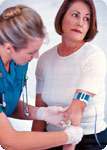|
Diabetes Mellitus is a silent chronic disorder in which we see blood sugar levels raised above normal, fasting above 120 mg/dl and post prandial above 140 mg/dl. This may be due to defective insulin secretion or defective insulin action or a combination of both. The result is an alteration in the digestion and utilization of carbohydrates, fats and proteins that we eat. Raised blood sugar levels cause changes in the blood vessels and thus can affect the eyes, kidneys, nerves, heart, brain and feet.  It is estimated that there are over 32 million diabetics in India and it could become It is estimated that there are over 32 million diabetics in India and it could become
57 million by 2025 says WHO. India is thus called Diabetic Capital of the World. Our mission as Dieticians and Nutritionist is to advise and educate not only present diabetics but all family members of diabetics so that they prevent and protect them selves from becoming diabetics.
All adult Indians should have their blood sugar levels tested especially if anybody in their family has diabetes or if they are overweight. If both parents are diabetic you have a 99% chance of getting diabetes. If one parent is diabetic and any other relative of non-diabetic parent is also diabetic 75% chance. If one parent is diabetic 50% chance. If any other close relative is diabetic 25% chance. Prevention: Diabetes
is mostly silent. Don't wait for symptoms like thirst, excessive urination and loss of weight, as they are late symptoms.
Early identification can help prevent diabetes
Prevention of diabetes is possible by lifestyle modifications - weight reduction regular walking and even if thin avoiding binge eating (over eating) or excess alcohol consumption.
If you have family history of diabetes please have a preventive diabetic check up.
- Recently a blood test has been introduced in which you can check serum insulin levels which can give you a clearer picture of whether you are prone to becoming diabetic or not.
Diabetes is classified into Type 1, Type 2, Gestational diabetes and Secondary diabetes. Type 1 diabetes  (previously called Insulin Dependent Diabetes Mellitus or IDDM) is usually seen in young children though it can occur at any age. It is caused by a damage in the beta cells of the pancreas resulting in insufficient production of insulin. The person will require insulin injections throughout. (previously called Insulin Dependent Diabetes Mellitus or IDDM) is usually seen in young children though it can occur at any age. It is caused by a damage in the beta cells of the pancreas resulting in insufficient production of insulin. The person will require insulin injections throughout. Type 2 diabetes (previously called Non- Insulin Dependent Diabetes or NIDDM) is mostly seen in adults and is believed to have a strong genetic influence. The main defect here is that the insulins action is affected. It occurs more frequently in obese individuals and responds well to oral medication Gestational Diabetes Mellitus (GDM) appears first during pregnancy. Such women usually have to be put on insulin along with diet for control of blood sugar, as oral hypoglycaemic agents have not yet been proved to be safe for use during pregnancy. Diabetes may settle after delivery in may cases but some women may continue to have diabetes. In general, women who develop gestational diabetes are at higher risk of developing type 2 diabetes late in life. Secondary
forms of diabetes are rare and these usually develop following other disorders like certain genetic abnormalities, alcoholic pancreatitis, infections and intake of certain drugs such as steroids, diuretics and certain psychiatric drugs. |